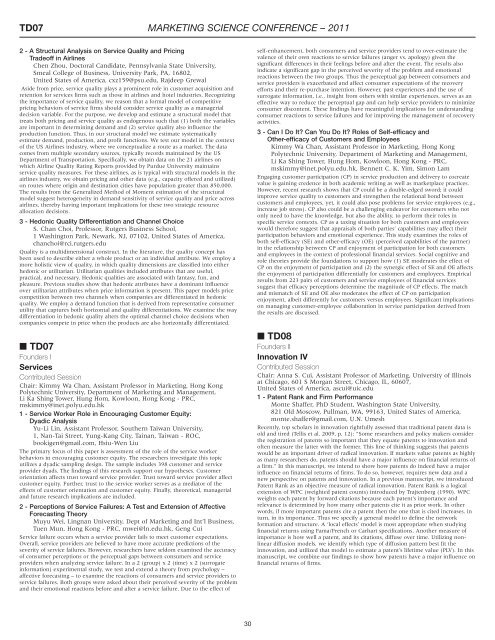Conference Sessions - Jesse H. Jones Graduate School of ...
Conference Sessions - Jesse H. Jones Graduate School of ...
Conference Sessions - Jesse H. Jones Graduate School of ...
Create successful ePaper yourself
Turn your PDF publications into a flip-book with our unique Google optimized e-Paper software.
TD07 MARKETING SCIENCE CONFERENCE – 2011<br />
2 - A Structural Analysis on Service Quality and Pricing<br />
Trade<strong>of</strong>f in Airlines<br />
Chen Zhou, Doctoral Candidate, Pennsylvania State University,<br />
Smeal College <strong>of</strong> Business, University Park, PA, 16802,<br />
United States <strong>of</strong> America, cxz159@psu.edu, Rajdeep Grewal<br />
Aside from price, service quality plays a prominent role in customer acquisition and<br />
retention for services firms such as those in airlines and hotel industries. Recognizing<br />
the importance <strong>of</strong> service quality, we reason that a formal model <strong>of</strong> competitive<br />
pricing behaviors <strong>of</strong> service firms should consider service quality as a managerial<br />
decision variable. For the purpose, we develop and estimate a structural model that<br />
treats both pricing and service quality as endogenous such that (1) both the variables<br />
are important in determining demand and (2) service quality also influence the<br />
production function. Thus, in our structural model we estimate systematically<br />
estimate demand, production, and pr<strong>of</strong>it functions. We test our model in the context<br />
<strong>of</strong> the US Airlines industry, where we conceptualize a route as a market. The data<br />
comes from multiple secondary sources, typically records maintained by the US<br />
Department <strong>of</strong> Transportation. Specifically, we obtain data on the 21 airlines on<br />
which Airline Quality Rating Reports provided by Purdue University maintains<br />
service quality measures. For these airlines, as is typical with structural models in the<br />
airlines industry, we obtain pricing and other data (e.g., capacity <strong>of</strong>fered and utilized)<br />
on routes where origin and destination cities have population greater than 850,000.<br />
The results from the Generalized Method <strong>of</strong> Moment estimation <strong>of</strong> the structural<br />
model suggest heterogeneity in demand sensitivity <strong>of</strong> service quality and price across<br />
airlines, thereby having important implications for these two strategic resource<br />
allocation decisions.<br />
3 - Hedonic Quality Differentiation and Channel Choice<br />
S. Chan Choi, Pr<strong>of</strong>essor, Rutgers Business <strong>School</strong>,<br />
1 Washington Park, Newark, NJ, 07102, United States <strong>of</strong> America,<br />
chanchoi@rci.rutgers.edu<br />
Quality is a multidimensional construct. In the literature, the quality concept has<br />
been used to describe either a whole product or an individual attribute. We employ a<br />
more holistic view <strong>of</strong> quality, in which quality dimensions are classified into either<br />
hedonic or utilitarian. Utilitarian qualities included attributes that are useful,<br />
practical, and necessary. Hedonic qualities are associated with fantasy, fun, and<br />
pleasure. Previous studies show that hedonic attributes have a dominant influence<br />
over utilitarian attributes when price information is present. This paper models price<br />
competition between two channels when companies are differentiated in hedonic<br />
quality. We employ a demand function that is derived from representative consumer<br />
utility that captures both horizontal and quality differentiations. We examine the way<br />
differentiation in hedonic quality alters the optimal channel choice decisions when<br />
companies compete in price when the products are also horizontally differentiated.<br />
■ TD07<br />
Founders I<br />
Services<br />
Contributed Session<br />
Chair: Kimmy Wa Chan, Assistant Pr<strong>of</strong>essor in Marketing, Hong Kong<br />
Polytechnic University, Department <strong>of</strong> Marketing and Management,<br />
Li Ka Shing Tower, Hung Hom, Kowloon, Hong Kong - PRC,<br />
mskimmy@inet.polyu.edu.hk<br />
1 - Service Worker Role in Encouraging Customer Equity:<br />
Dyadic Analysis<br />
Yu-Li Lin, Assistant Pr<strong>of</strong>essor, Southern Taiwan University,<br />
1, Nan-Tai Street, Yung-Kang City, Tainan, Taiwan - ROC,<br />
bookigen@gmail.com, Hsiu-Wen Liu<br />
The primary focus <strong>of</strong> this paper is assessment <strong>of</strong> the role <strong>of</strong> the service worker<br />
behaviors in encouraging customer equity. The researchers investigate this topic<br />
utilizes a dyadic sampling design. The sample includes 398 customer and service<br />
provider dyads. The findings <strong>of</strong> this research support our hypotheses. Customer<br />
orientation affects trust toward service provider. Trust toward service provider affect<br />
customer equity. Further, trust to the service worker serves as a mediator <strong>of</strong> the<br />
effects <strong>of</strong> customer orientation and customer equity. Finally, theoretical, managerial<br />
and future research implications are included.<br />
2 - Perceptions <strong>of</strong> Service Failures: A Test and Extension <strong>of</strong> Affective<br />
Forecasting Theory<br />
Muyu Wei, Lingnan University, Dept <strong>of</strong> Marketing and Int’l Business,<br />
Tuen Mun, Hong Kong - PRC, mwei@ln.edu.hk, Geng Cui<br />
Service failure occurs when a service provider fails to meet customer expectations.<br />
Overall, service providers are believed to have more accurate predictions <strong>of</strong> the<br />
severity <strong>of</strong> service failures. However, researchers have seldom examined the accuracy<br />
<strong>of</strong> consumer perceptions or the perceptual gaps between consumers and service<br />
providers when analyzing service failure. In a 2 (group) x 2 (time) x 2 (surrogate<br />
information) experimental study, we test and extend a theory from psychology –<br />
affective forecasting – to examine the reactions <strong>of</strong> consumers and service providers to<br />
service failures. Both groups were asked about their perceived severity <strong>of</strong> the problem<br />
and their emotional reactions before and after a service failure. Due to the effect <strong>of</strong><br />
30<br />
self-enhancement, both consumers and service providers tend to over-estimate the<br />
valence <strong>of</strong> their own reactions to service failures (anger vs. apology) given the<br />
significant differences in their feelings before and after the event. The results also<br />
indicate a significant gap in the perceived severity <strong>of</strong> the problem and emotional<br />
reactions between the two groups. Thus the perceptual gap between consumers and<br />
service providers is exacerbated and affect consumer expectations <strong>of</strong> the recovery<br />
efforts and their re-purchase intention. However, past experiences and the use <strong>of</strong><br />
surrogate information, i.e., insight from others with similar experiences, serves as an<br />
effective way to reduce the perceptual gap and can help service providers to minimize<br />
consumer discontent. These findings have meaningful implications for understanding<br />
consumer reactions to service failures and for improving the management <strong>of</strong> recovery<br />
activities.<br />
3 - Can I Do It? Can You Do It? Roles <strong>of</strong> Self-efficacy and<br />
Other-efficacy <strong>of</strong> Customers and Employees<br />
Kimmy Wa Chan, Assistant Pr<strong>of</strong>essor in Marketing, Hong Kong<br />
Polytechnic University, Department <strong>of</strong> Marketing and Management,<br />
Li Ka Shing Tower, Hung Hom, Kowloon, Hong Kong - PRC,<br />
mskimmy@inet.polyu.edu.hk, Bennett C. K. Yim, Simon Lam<br />
Engaging customer participation (CP) in service production and delivery to cocreate<br />
value is gaining credence in both academic writing as well as marketplace practices.<br />
However, recent research shows that CP could be a double-edged sword; it could<br />
improve service quality to customers and strengthen the relational bond between<br />
customers and employees, yet, it could also pose problems for service employees (e.g.,<br />
increase job stress). CP also could be a challenging endeavor for customers who not<br />
only need to have the knowledge, but also the ability, to perform their roles in<br />
specific service contexts. CP as a taxing situation for both customers and employees<br />
would therefore suggest that appraisals <strong>of</strong> both parties’ capabilities may affect their<br />
participation behaviors and emotional experience. This study examines the roles <strong>of</strong><br />
both self-efficacy (SE) and other-efficacy (OE) (perceived capabilities <strong>of</strong> the partner)<br />
in the relationship between CP and enjoyment <strong>of</strong> participation for both customers<br />
and employees in the context <strong>of</strong> pr<strong>of</strong>essional financial services. Social cognitive and<br />
role theories provide the foundations to support how (1) SE moderates the effect <strong>of</strong><br />
CP on the enjoyment <strong>of</strong> participation and (2) the synergic effect <strong>of</strong> SE and OE affects<br />
the enjoyment <strong>of</strong> participation differentially for customers and employees. Empirical<br />
results from 223 pairs <strong>of</strong> customers and service employees <strong>of</strong> financial services<br />
suggest that efficacy perceptions determine the magnitude <strong>of</strong> CP effects. The match<br />
and mismatch <strong>of</strong> SE and OE also moderates the effect <strong>of</strong> CP on participation<br />
enjoyment, albeit differently for customers versus employees. Significant implications<br />
on managing customer-employee collaboration in service participation derived from<br />
the results are discussed.<br />
■ TD08<br />
Founders II<br />
Innovation IV<br />
Contributed Session<br />
Chair: Anna S. Cui, Assistant Pr<strong>of</strong>essor <strong>of</strong> Marketing, University <strong>of</strong> Illinois<br />
at Chicago, 601 S Morgan Street, Chicago, IL, 60607,<br />
United States <strong>of</strong> America, ascui@uic.edu<br />
1 - Patent Rank and Firm Performance<br />
Monte Shaffer, PhD Student, Washington State University,<br />
821 Old Moscow, Pullman, WA, 99163, United States <strong>of</strong> America,<br />
monte.shaffer@gmail.com, U.N. Umesh<br />
Recently, top scholars in innovation rightfully assessed that traditional patent data is<br />
old and tired (Tellis et al. 2009, p. 12): “Some researchers and policy makers consider<br />
the registration <strong>of</strong> patents so important that they equate patents to innovation and<br />
<strong>of</strong>ten measure the latter with the former. This line <strong>of</strong> thinking suggests that patents<br />
would be an important driver <strong>of</strong> radical innovation. If markets value patents as highly<br />
as many researchers do, patents should have a major influence on financial returns <strong>of</strong><br />
a firm.” In this manuscript, we intend to show how patents do indeed have a major<br />
influence on financial returns <strong>of</strong> firms. To do so, however, requires new data and a<br />
new perspective on patents and innovation. In a previous manuscript, we introduced<br />
Patent Rank as an objective measure <strong>of</strong> radical innovation. Patent Rank is a logical<br />
extension <strong>of</strong> WPC (weighted patent counts) introduced by Trajtenberg (1990). WPC<br />
weights each patent by forward citations because each patent’s importance and<br />
relevance is determined by how many other patents cite it as prior work. In other<br />
words, if more important patents cite a patent then the one that is cited increases, in<br />
turn, in its importance. Thus we specify a general model to define the network<br />
formation and structure. A ‘local effects’ model is most appropriate when studying<br />
financial returns using Fama/French or Carhart specifications. Another measure <strong>of</strong><br />
importance is how well a patent, and its citations, diffuse over time. Utilizing nonlinear<br />
diffusion models, we identify which type <strong>of</strong> diffusion pattern best fit the<br />
innovation, and utilized that model to estimate a patent’s lifetime value (PLV). In this<br />
manuscript, we combine our findings to show how patents have a major influence on<br />
financial returns <strong>of</strong> firms.

















